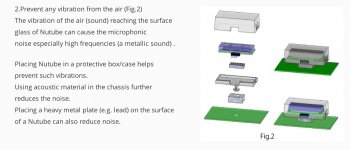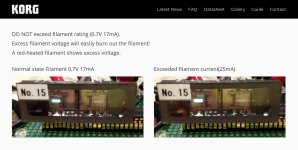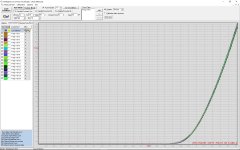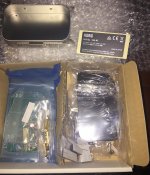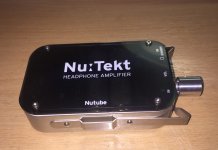Is the vibration caused by the chassis vibrating or also air pressure from sound?
Chassis vibrating can be solved by making the chassis heavy and well dampened inside. If it is also the air moving caused by sound pressure then the chassis should also be almost airtight?
Chassis vibrating can be solved by making the chassis heavy and well dampened inside. If it is also the air moving caused by sound pressure then the chassis should also be almost airtight?
It can be both. An interface can absorb from both directions i.e. board to chassis and chassis to board. If there is tons of energy from the air directly on the elements of the tube, probably they will sing, but that generally is not the case.
I think I will put small springs on the screw mounts of the PCB alter, as suggested by the contributor who cited Naim gear, and surgical silastic under the board. The silastic is non conducting.
I have been using stuff to isolate other types of microphonic directly heated triode stages using various methods for a while.
Silastic is nice because you can 'see' that the Hz sink of the twanged component is less than 5Hz by finger poke, and you can also 'see' the decay rate of less than a second. The gel also operates 360 degrees. With the energies involved, that is usually adequate.
I think I will put small springs on the screw mounts of the PCB alter, as suggested by the contributor who cited Naim gear, and surgical silastic under the board. The silastic is non conducting.
I have been using stuff to isolate other types of microphonic directly heated triode stages using various methods for a while.
Silastic is nice because you can 'see' that the Hz sink of the twanged component is less than 5Hz by finger poke, and you can also 'see' the decay rate of less than a second. The gel also operates 360 degrees. With the energies involved, that is usually adequate.
Ok......will follow what people finds out regarding damping of the Nutube before I finalize my Korg's.
Pete Millett (USA Nutube distributor) supplies sticky foam with the tubes, as received by the USA participants.
Fancy DACs with fancy crystals often employ orings on the standoffs, or even oring-suspended PCB sections.
Bitumen or similar on sturdy case panels seems like a good idea. Like speaker building.
BK
Fancy DACs with fancy crystals often employ orings on the standoffs, or even oring-suspended PCB sections.
Bitumen or similar on sturdy case panels seems like a good idea. Like speaker building.
BK
Attachments
Looks good, Soundhappy. I know that when nuvistors (also microphonic) were used in the past, Conrad Johnson had the boards suspended in the chassis for microphonics.
I have one nuvistor device (headamp) and the silastic surgical gel under the chassis on the outside does the trick to scotch any detectable microphonics.
With heavier tubed components, a combination of rollerball feet and a pad of silastic is very effective.
Yes in Japan : Nutube Accessory KIT NUTUBE-ACCESSORY-KIT-01の通販ならマルツオンラインIs it possible to buy such a "kit"?
With small plastic or plexi box and perfboard we can DIY something similar for cheap.
Do we really need this stuff ? Papa find simple solution and " work like a glue " 😀
If this is a real problem I'll solder the nutube to the pcb and mount the pcb (as cjfrbw mentioned) on some rubber dampers, also make the chassis heavier, if needed. My Altec A5s do move some air 🙂
Last edited:
Looks good, Soundhappy....I have one nuvistor device (headamp) and the silastic surgical gel under the chassis on the outside does the trick to scotch any detectable microphonics.
With heavier tubed components, a combination of rollerball feet and a pad of silastic is very effective.
Thanks Cjfrbw
Yes + 1 for simple to do and very effective solution 🙂
Have my Pass B1 nutube running! It certainly deserves a nice chassis later on!
I have no noticeable ringing issues, it needed proper grounding to eliminate idle noise.
My 9.1v zener gives 9.5v which give 0.7v on the heaters.
So overall a very very enjoyable preamp. A keeper...
@ Asanden
Congratulations

Attachments
Despite my build being complete for a while I had yet to hear its beauty until tonight. I had ordered all the pieces to assemble a muses volume control but as that is still a ways off, I scavanged a 10K pot off another preamp and wired it up to hear the magic.... I was not disappointed - might be ZMs mighty SIT or too much of a good thing but it sounded glorious . Thanks to Papa for such a treasured gift 
..dB

..dB
I was supposed to ship this week, but got entangled in various and
sundry. I might get them out today....
sundry. I might get them out today....
nu tube Headphone amp..
Sorry to intrude with this...bit off topic but I am so impressed with the NP B1 Triode I thought I'd have a go at the Korg HA K1 headphone amp...it really is very good. And absolutely no ringing what so ever. All for a bit of foam in the right places.
Sorry to intrude with this...bit off topic but I am so impressed with the NP B1 Triode I thought I'd have a go at the Korg HA K1 headphone amp...it really is very good. And absolutely no ringing what so ever. All for a bit of foam in the right places.
Attachments
I was looking at attenuators. Everything from a regular ALPS pot, to the Muse chip and even Variable Gain. I guess Variable Gain to attenuate volume would change the carefully selected harmonics, which is the whole point of the preamp. The way Ayre describes variable gain it seems really clever, but only if the circuit allows for it.
Last edited:
- Home
- Amplifiers
- Pass Labs
- B1 with Korg Triode

